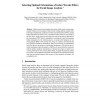Free Online Productivity Tools
i2Speak
i2Symbol
i2OCR
iTex2Img
iWeb2Print
iWeb2Shot
i2Type
iPdf2Split
iPdf2Merge
i2Bopomofo
i2Arabic
i2Style
i2Image
i2PDF
iLatex2Rtf
Sci2ools
ICISP
2010
Springer
2010
Springer
Selecting Optimal Orientations of Gabor Wavelet Filters for Facial Image Analysis
Abstract. Gabor wavelet-based methods have been widely used to extract representative features for face analysis. However, the existing methods usually suffer from high computational complexity of Gabor wavelet transform (GWT), and the Gabor parameters are fixed to a few conventional values which are assumed to be the best choice. In this paper we show that, for some facial analysis applications, the conventional GWT could be simplified by selecting the most discriminating Gabor orientations. In the selection process, we analyze the histogram of oriented gradient (HOG) of the average face image in a dataset, and eliminate the less significant orientation combinations. Then we traverse the rest combinations and select the best according to classification performance. We find that the selected orientations match the analysis of HOG well, and are therefore consistent with the intrinsic gradient characteristics of human face images. In order to assess the performance of the selected Gabor ...
Discriminating Gabor Orientations | Gabor Wavelet Transform | Gabor Wavelet-based Methods | ICISP 2010 | Image Processing |
Related Content
| Added | 18 Oct 2010 |
| Updated | 18 Oct 2010 |
| Type | Conference |
| Year | 2010 |
| Where | ICISP |
| Authors | Tianqi Zhang, Bao-Liang Lu |
Comments (0)

